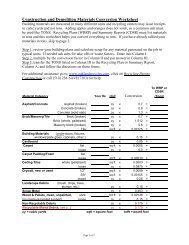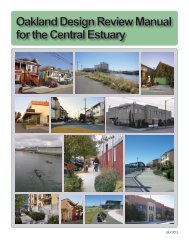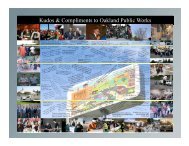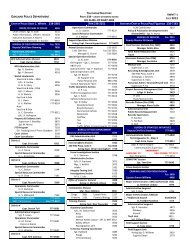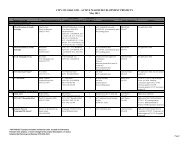Intelligent Transportation Systems - City of Oakland
Intelligent Transportation Systems - City of Oakland
Intelligent Transportation Systems - City of Oakland
You also want an ePaper? Increase the reach of your titles
YUMPU automatically turns print PDFs into web optimized ePapers that Google loves.
throughout the <strong>City</strong>. This is enabled through a direct video feed between the ADOT<br />
TMC in Phoenix and the cable television station.<br />
KTOP Cable Channel 10 is a community access television program that is currently<br />
broadcasting in the <strong>City</strong> <strong>of</strong> <strong>Oakland</strong>. KTOP’s mission is to “provide quality programming<br />
that seeks to mobilize the <strong>Oakland</strong> community toward civic participation, promotes civic<br />
pride and showcases the cultural diversity that makes our city a unique and exciting<br />
place to live and work.” Most current programming consists <strong>of</strong> coverage <strong>of</strong> <strong>City</strong> Council,<br />
Council Committee, and other <strong>City</strong> Agency meetings but other stated KTOP priorities<br />
include providing emergency information and serving the public information<br />
dissemination needs <strong>of</strong> <strong>City</strong> Departments and city sponsored public agencies.<br />
Cable Television Recommendations:<br />
It is recommended that the <strong>City</strong> <strong>of</strong> <strong>Oakland</strong> pursue an arrangement with KTOP to<br />
broadcast local traveler information to <strong>Oakland</strong> residents. This could involve<br />
establishing a morning time slot on the channel dedicated traveler information for<br />
<strong>Oakland</strong> commuters. The traveler information could be provided through a direct link<br />
with the <strong>Oakland</strong> TMC and may include a tour <strong>of</strong> <strong>City</strong> traffic cameras at key locations or<br />
display <strong>of</strong> a citywide traffic map similar to one that would be displayed on a web site.<br />
The CATV agreement would most likely be a medium- or long-term initiative since it<br />
would require first having an operational TMC and ATMS.<br />
4.4 TRANSIT MANAGEMENT SYSTEMS<br />
Accommodating multiple modes <strong>of</strong> travel in the <strong>City</strong> <strong>of</strong> <strong>Oakland</strong> is important to the<br />
overall project objectives. There are a number <strong>of</strong> ITS applications that can enhance the<br />
efficiency <strong>of</strong> public transportation systems and improve the flow <strong>of</strong> transit information to<br />
riders. The following discussion identifies methods or applications that can help<br />
maintain and enhance the transit services within the <strong>City</strong> <strong>of</strong> <strong>Oakland</strong>.<br />
4.4.1 Transit Signal Priority (TSP)<br />
TSP is an operational strategy that facilitates the movement <strong>of</strong> buses through trafficsignal<br />
controlled intersections. TSP can reduce transit delay and travel time by reducing<br />
the time transit vehicles spend at intersections. This also improves transit service<br />
reliability which increases the transit system’s quality <strong>of</strong> service.<br />
TSP modifies the normal signal operation process without significantly impacting other<br />
traffic. There are several possible signal treatments to provide priority to the transit<br />
vehicles. This includes, but not limited to “early green” which shortens the green time <strong>of</strong><br />
a preceding phase to return to a green phase where the transit vehicle has been<br />
detected. Another strategy is to have a “green extension” which increases the green<br />
time for the phase where a transit vehicle has been detected. Both <strong>of</strong> these strategies<br />
have been effectively applied throughout Bay Area communities.<br />
TSP works at the local intersection by detecting the approaching transit vehicle<br />
upstream <strong>of</strong> the signalized intersection and sending a call to the traffic signal controller.<br />
Depending on when the transit vehicle is detected in relation to the controllers cycle it<br />
may or may not trigger a signal priority event. The signal controller would then decide to<br />
use an “early green” strategy, “green extension” or stay on the current cycle plan.<br />
<strong>City</strong> <strong>of</strong> <strong>Oakland</strong> ITS Strategic Plan<br />
50 September, 2003







